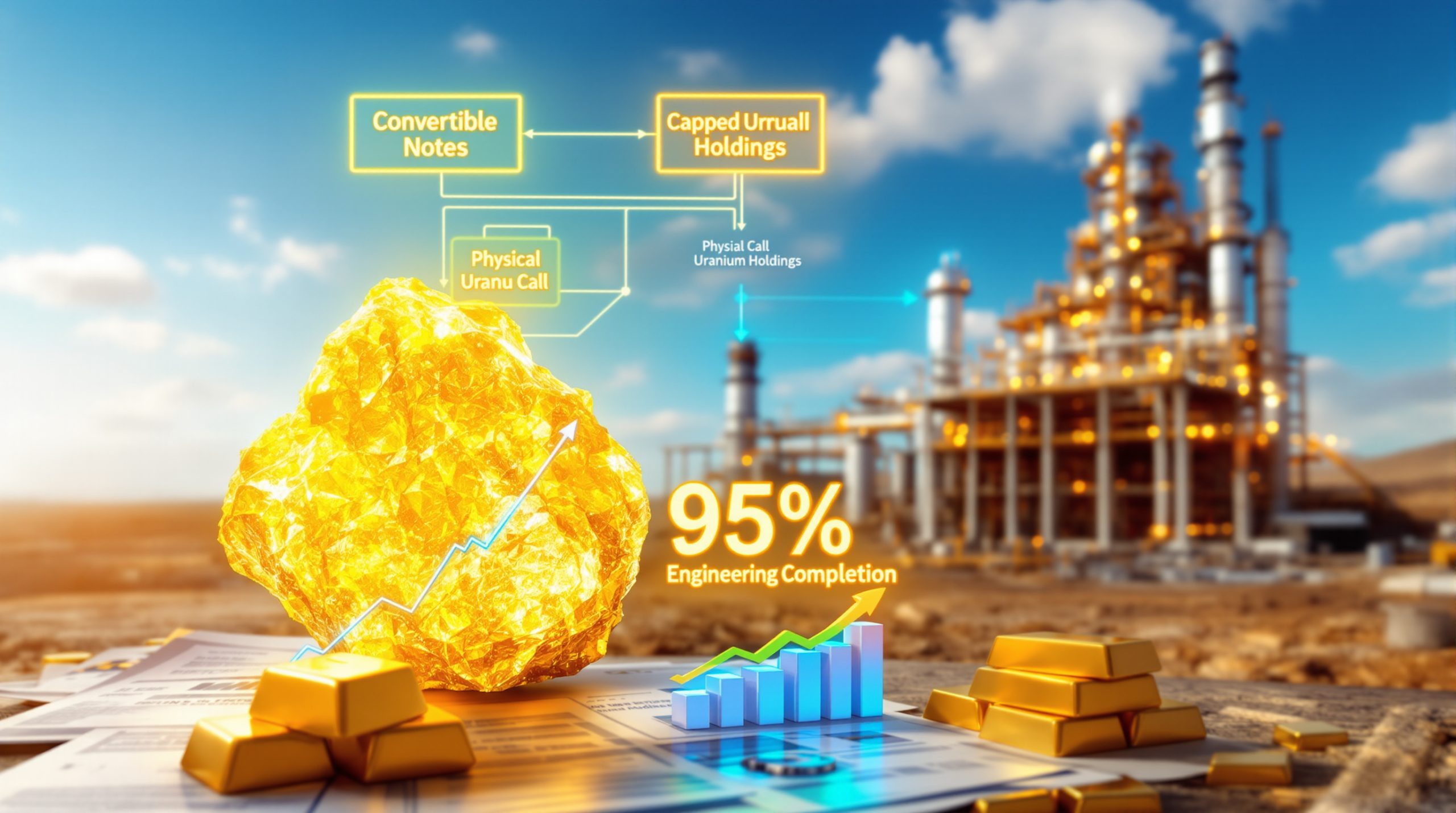What is Gold Mountain Asset Management's New Fund?
The Launch of a Specialized Metals Fund in Hong Kong
Gold Mountain Asset Management, an overseas subsidiary of China's Zijin Mining Group, has recently expanded access to its gold and copper fund in Hong Kong to professional investors. This specialized fund, which officially opened to external investors on May 21, 2025, marks a significant shift in accessibility, as it was previously only available to Zijin Mining Group's internal companies and employees.
As China's third-largest gold producer according to the 2024 China Gold Association report, Zijin Mining brings substantial industry expertise to this investment vehicle. The fund represents a strategic move to capitalize on growing investor interest in precious and industrial metals during a period of economic uncertainty.
Investment Strategy and Portfolio Focus
The fund specifically targets investments in gold and copper exploration assets, leveraging Zijin Mining Group's extensive operational experience in these metals. Unlike broader resource funds that might dilute exposure across numerous commodities, Gold Mountain's targeted approach allows investors to gain specific exposure to two metals with complementary market dynamics.
"We are bullish on gold, as geopolitical uncertainties and unresolved trade frictions will support prices," explains Lisa Liu Sha, Managing Director at Gold Mountain Asset Management, highlighting the strategic thinking behind the fund's focused approach.
This specialized investment strategy draws directly from Zijin Mining strategy and practical mining expertise, particularly its significant copper operations in Fujian province, which serve as a strategic asset in the company's portfolio. By tapping into this operational knowledge, the fund aims to identify investment opportunities that might be overlooked by generalist resource investors without deep sector experience.
Why Are Gold Prices Expected to Reach Record Highs?
Bullish Price Projections for 2025
According to Lisa Liu Sha, Managing Director and Portfolio Manager at Gold Mountain, gold prices could potentially reach US$4,000 per ounce during 2025. This represents a significant increase from the current price of US$3,223.55 (as of May 20, 2025), suggesting a potential upside of approximately 24% from current levels.
This bullish outlook comes amid a notable market response to macroeconomic developments – gold prices already showed positive momentum with a 0.7% increase following Moody's downgrade of US government debt from Aaa to Aa1 on May 16, 2025. This immediate price reaction demonstrates how sovereign risk assessments continue to influence precious metal valuations.
Key Factors Driving Gold's Price Momentum
Several interconnected factors are creating favorable conditions for gold price forecast appreciation:
-
Weakening US Dollar: The recent credit rating downgrade by Moody's has put additional pressure on the dollar, enhancing gold's appeal as an alternative store of value. Historically, gold has shown an inverse relationship with dollar strength.
-
Central Bank Accumulation: Global central banks added an impressive 1,037 tonnes to their reserves in 2024 according to the World Gold Council, continuing a multi-year trend of reserve diversification away from traditional fiat currencies.
-
Geopolitical Uncertainties: Ongoing international tensions across multiple regions have increased demand for safe-haven assets, with gold traditionally benefiting during periods of heightened global instability.
-
Persistent Trade Frictions: Unresolved global trade disputes continue to create market volatility and uncertainty about future economic growth trajectories, further supporting gold's traditional role as a portfolio stabilizer.
Supply Constraints Supporting Higher Prices
Beyond demand factors, structural supply limitations in the gold market are creating additional price support. As Lisa Liu Sha notes, "Gold's supply constraints are structural," referring to the increasingly challenging nature of discovering and developing new gold deposits globally.
The combination of declining discovery rates, lower average ore grades, and lengthening timelines for mine development has created a situation where new supply struggles to keep pace with growing investment and central bank demand – a fundamental imbalance that could support sustainably higher prices.
What Makes Zijin Mining Group a Significant Player?
Company Profile and Market Position
Zijin Mining Group stands as one of China's largest metals producers, with a dominant position in both gold and copper markets. According to the company's 2023 Annual Report, Zijin produced 1.07 million tonnes of copper that year, making it China's largest copper producer, while also ranking as the country's third-largest gold miner.
This scale of operations provides Gold Mountain Asset Management with unique insights into metals markets that might not be available to other fund managers without direct mining industry connections. The company's dual expertise in both gold and copper creates natural synergies for a fund focused specifically on these two metals.
Strategic Mining Assets and Global Footprint
While Zijin's Fujian copper mine exemplifies its strategic domestic assets, the company's footprint extends far beyond China's borders. Operating in 15 countries across multiple continents, Zijin has systematically expanded its global presence through strategic acquisitions and development projects.
Notable international holdings include Serbia's Bor copper complex, which represents one of Europe's largest copper resources. This global diversification not only reduces operational risk but also provides Zijin with first-hand market intelligence across different regulatory and geological environments.
The company's combination of scale, operational expertise, and international presence has positioned it as a mining powerhouse capable of influencing global markets – particularly in copper, where supply development requires increasingly sophisticated technical capabilities and substantial capital investment.
How Do Copper and Gold Markets Compare as Investment Options?
Complementary Metals with Different Market Drivers
While both metals are targeted by the Gold Mountain fund, they respond to different economic conditions and offer complementary investment characteristics:
| Metal | Primary Use Cases | Key Price Drivers | Current Market Dynamics |
|---|---|---|---|
| Gold | Investment, jewelry, central bank reserves | Inflation hedging, safe-haven demand, dollar strength | Rising on monetary uncertainty and geopolitical risks |
| Copper | Industrial applications, construction, electronics | Economic growth, infrastructure spending, electrification trends | Supported by green energy transition and infrastructure development |
This complementary relationship makes the dual focus of the Gold Mountain fund particularly attractive, as it offers natural portfolio diversification within a single investment vehicle. As Lisa Liu Sha explains, copper's "green energy transition demand" complements gold's safe-haven role in a well-balanced metals portfolio.
The Copper Advantage: Essential for Electrification
Copper's unique physical properties – exceptional electrical conductivity, corrosion resistance, and thermal transfer capabilities – make it irreplaceable in many applications central to the global energy transition. Modern electric vehicles require approximately 83 kg of copper per vehicle (CRU Group, 2023), compared to just 23 kg in conventional internal combustion vehicles.
China alone accounts for approximately 50% of global copper demand according to the International Copper Study Group (2024), driven by its manufacturing sector, infrastructure development, and growing emphasis on renewable energy. This concentration of demand creates both opportunities and risks for copper price insights.
Looking forward, Wood Mackenzie projects an 8.5 million tonne copper supply deficit by 2030, highlighting the potential for significant price appreciation as demand outpaces new mine development. This supply-demand imbalance represents a fundamental catalyst for copper prices that differs from gold's more monetary and sentiment-driven value proposition.
Investment Case for Dual Exposure
The fund's focus on both metals offers investors potential portfolio benefits through:
-
Diversification: Gold typically performs well during economic uncertainty while copper often benefits from growth periods, creating natural hedging within the fund
-
Green Energy Transition: Copper demand is structurally linked to renewable energy infrastructure and electric vehicles, with each new wind turbine requiring up to 4.7 tonnes of copper
-
Inflation Protection: Both metals have historically provided hedging against inflation, albeit through different mechanisms
-
Supply Constraints: Both metals face significant challenges in bringing new supply online, supporting long-term price fundamentals
This balanced approach provides exposure to both defensive and growth-oriented metal markets, potentially reducing volatility while maintaining upside potential across different economic scenarios.
Who Can Access the Gold Mountain Fund in Hong Kong?
Investor Eligibility Requirements
The Gold Mountain fund is specifically available to professional investors in Hong Kong as defined by the Securities and Futures Commission (SFC). Under SFC regulations, these typically include:
-
Institutional investors such as banks, insurance companies, and pension funds
-
High-net-worth individuals who maintain investment portfolios of at least HK$8 million (approximately US$1 million)
-
Qualified investment entities meeting specific asset thresholds and regulatory requirements
This restricted access is common for specialized investment products in Hong Kong and reflects the fund's targeted approach to sophisticated investors with the capacity to evaluate commodity-specific risk factors.
Regulatory Framework and Investor Protections
As with other specialized investment products in Hong Kong, the Gold Mountain fund operates within the regulatory framework established by the Securities and Futures Commission, which provides oversight for investment products marketed to professional investors.
While professional investor funds have fewer disclosure requirements than retail products, they must still adhere to SFC standards regarding risk disclosures and suitability assessments. This regulatory approach balances access to specialized investment strategies with appropriate investor protection measures.
Potential investors should consult with financial advisors familiar with Hong Kong's professional investor requirements to determine their eligibility and the suitability of the fund for their specific portfolio needs.
What's the Outlook for Gold and Copper Markets?
Gold Market Projections
The outlook for gold appears particularly strong, with multiple factors converging to support Lisa Liu Sha's price target of US$4,000 per ounce by the end of 2025:
-
Central Bank Purchasing: The trend of central bank gold accumulation shows no signs of slowing, with the World Gold Council reporting 1,037 tonnes added to global reserves in 2024
-
Sovereign Debt Concerns: Moody's recent downgrade of US government debt highlights growing concerns about fiscal sustainability among major economies
-
Supply Limitations: Gold discovery rates have declined significantly, with major new finds becoming increasingly rare despite elevated exploration budgets
-
Investment Demand: Persistent geopolitical uncertainties continue to drive safe-haven investment flows into gold-backed exchange-traded funds and physical bullion
Together, these factors create a supportive environment for gold market trends, particularly if dollar weakness accelerates or inflation proves more persistent than currently anticipated by central banks.
Copper Market Considerations
The copper market outlook is equally compelling but driven by different fundamental factors:
-
Energy Transition Demand: The International Energy Agency projects that renewable energy installations will require over 3 million tonnes of additional copper annually by 2030
-
Electric Vehicle Growth: With each electric vehicle requiring nearly four times more copper than conventional vehicles, automotive electrification represents a significant demand driver
-
Supply Development Challenges: New copper projects face increasingly lengthy development timelines, with the average mine now taking over 15 years from discovery to production
-
Resource Nationalism: Producing countries including Chile and Peru have implemented or proposed higher mining taxes, potentially constraining investment in new capacity
These factors have led Goldman Sachs to project copper prices reaching US$15,000 per tonne by mid-2025, representing significant upside from current levels. This bullish outlook is supported by Wood Mackenzie's projection of an 8.5 million tonne supply deficit by 2030.
Balancing Opportunity and Risk
While the outlook for both metals appears positive, investors should remain conscious of potential risks, including:
-
Monetary Policy Shifts: Unexpected changes in interest rate trajectories could impact gold's relative attractiveness
-
Chinese Demand Fluctuations: As China consumes approximately 50% of global copper production, economic slowdowns there could disproportionately impact prices
-
Technological Substitution: Higher copper prices could accelerate substitution efforts, particularly in non-critical applications
-
Recycling Rates: Improved metal recovery from electronic waste and other sources could partially offset primary supply constraints
These risk factors highlight the importance of active management in metals-focused investments, an area where Gold Mountain's connection to Zijin Mining may provide valuable industry insights.
FAQ About Gold and Copper Investments
How do gold investments typically perform during economic uncertainty?
Gold has historically served as a store of value during periods of economic turbulence, often moving inversely to traditional equity markets. During the 2008 global financial crisis, gold delivered positive returns of approximately 5% while the S&P 500 declined by 38% (World Gold Council).
This counter-cyclical performance stems from gold's perceived safe-haven status, limited correlation with other asset classes, and absence of counterparty risk. During times of heightened uncertainty, investors frequently increase allocations to gold as a portfolio diversifier and potential hedge against systemic risks.
However, performance can vary significantly depending on the specific nature of economic challenges, particularly when considering currency movements and real interest rate environments.
What factors differentiate copper from other industrial metals?
Copper's exceptional electrical conductivity, corrosion resistance, and thermal properties make it essential for electrical systems, construction, and renewable energy infrastructure. Unlike some industrial metals with ready substitutes, copper's unique combination of properties makes it difficult to replace in many applications, supporting long-term demand fundamentals.
Additionally, copper faces more significant supply development challenges than many other metals. The average copper grade of new discoveries has declined substantially over the past decades, requiring more extensive processing to produce the same amount of refined metal. This combination of irreplaceability and supply constraints creates a structural support for copper prices that distinguishes it from more abundant industrial metals.
How might central bank policies impact gold prices?
Central bank monetary policies, particularly interest rate decisions and quantitative easing programs, significantly influence gold prices. Lower interest rates reduce the opportunity cost of holding non-yielding assets like gold, while expansionary monetary policies can raise inflation concerns, potentially increasing gold's appeal as an inflation hedge.
Beyond these direct effects, central banks themselves have become substantial gold buyers in recent years. The World Gold Council reports that central banks added 1,037 tonnes to reserves in 2024, representing a significant source of demand separate from traditional investment and jewelry markets.
This combination of policy impacts and direct purchasing activity makes central bank decisions particularly important for gold market participants to monitor.
What role does China play in global copper demand?
China remains the world's largest copper consumer, accounting for approximately 50% of global demand according to the International Copper Study Group. The country's infrastructure development, manufacturing sector, and growing emphasis on renewable energy and electric vehicles continue to drive substantial copper requirements.
In 2024, China consumed approximately 12.5 million tonnes of refined copper (National Bureau of Statistics), highlighting the scale of its market influence. This concentration of demand makes Chinese economic policies, urbanization trends, and energy transition plans critical factors for copper market participants.
While this concentration creates potential vulnerability to Chinese economic slowdowns, it also means that stimulus measures targeting infrastructure or clean energy development can have outsized positive impacts on copper demand and pricing. The Chinese copper trading market continues to be a significant driver of global price movements.
Disclaimer: This article contains forecasts and market analysis that represent opinions and estimates. These projections are subject to uncertainties and external factors that may cause actual results to differ materially from those discussed. Investors should conduct their own research and consult with financial advisors before making investment decisions based on the information presented.
Ready to Invest in the Next Major Mineral Discovery?
Discover why historic mineral findings can generate substantial returns by exploring Discovery Alert's proprietary Discovery IQ model, which instantly turns complex mineral data into actionable insights for ASX investors. Begin your 30-day free trial today at Discovery Alert's discoveries page to position yourself ahead of the market.




